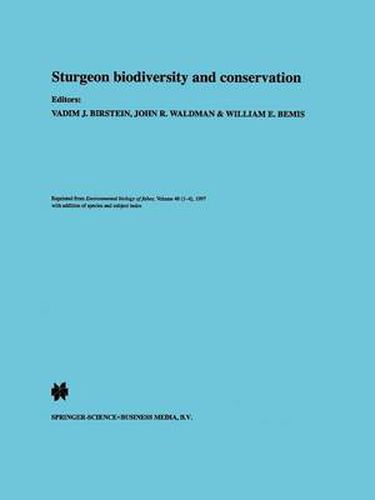Readings Newsletter
Become a Readings Member to make your shopping experience even easier.
Sign in or sign up for free!
You’re not far away from qualifying for FREE standard shipping within Australia
You’ve qualified for FREE standard shipping within Australia
The cart is loading…






This title is printed to order. This book may have been self-published. If so, we cannot guarantee the quality of the content. In the main most books will have gone through the editing process however some may not. We therefore suggest that you be aware of this before ordering this book. If in doubt check either the author or publisher’s details as we are unable to accept any returns unless they are faulty. Please contact us if you have any questions.
Acipenser brevirostrum female 58 cm long from the Hudson River near Kingston, New York, above Acipenser oxyrinchus male 58 cm long from the Lawrence River near St. Vallier, Quebec, by Paul I. Voevodine from Vladykov & Greeley (1963). 1 Sturgeon landing on the Volga River. From an engraving in Moynet . p. 85. 1 Moynet, M. 1867. LaVolga. LeTourduMonde15: 81-96. Environmental Biology of Fishes 48: 373-380,1997. © 1997 Kluwer Academic Publishers. Printed in the Netherlands. Sturgeons and the Aral Sea ecological catastrophe Iliya Zholdasova Institute of Bioecology, Karakalpak Branch of the Academy of Sciences of Uzbekistan, Nukus, Republic Ka- kalpakstan Received5.4.1995 Accepted16.3.1996 Key words: Amu-Dar River, Syr-Dar River, Pseudoscaphirhynchus kaufmanni, P. fedtschenkoi, P. hermanni, Acipenser nudiventris, pollution, acclimatization, Nitzschia Synopsis A short description of the catastrophic changes in the ecology of the Aral Sea basin during the three last decades is presented. These changes have influenced the status oftwo acipenserid endemics to the area, the large Amu-Dar shovelnose, Pseudoscaphirhynchus kaufmanni, and the ship sturgeon,Acipensernudiventris. The main biological characteristics ofboth species in the new environmental conditions are given. Previous unsuccessful attempts to introduce other acipenserid species into the area are also described. International cooperationisneededforsavingthelastsurvivingspeciesrepresentingthegenusPseudoscaphirhynchus.The only twootherspeciesofthe same genus, P.fedtschenkoi and P . hermanni, have alreadybecome victims ofthe Aral Sea catastrophe and are apparently extinct. Introduction 1993). Twosturgeonspecies, the Syr-Dar and small Amu-Dar shovelnose sturgeons, were among the Historically the endemic fauna ofthe Aral Sea ba- first victims of this disaster and seem to be extinct.
$9.00 standard shipping within Australia
FREE standard shipping within Australia for orders over $100.00
Express & International shipping calculated at checkout
This title is printed to order. This book may have been self-published. If so, we cannot guarantee the quality of the content. In the main most books will have gone through the editing process however some may not. We therefore suggest that you be aware of this before ordering this book. If in doubt check either the author or publisher’s details as we are unable to accept any returns unless they are faulty. Please contact us if you have any questions.
Acipenser brevirostrum female 58 cm long from the Hudson River near Kingston, New York, above Acipenser oxyrinchus male 58 cm long from the Lawrence River near St. Vallier, Quebec, by Paul I. Voevodine from Vladykov & Greeley (1963). 1 Sturgeon landing on the Volga River. From an engraving in Moynet . p. 85. 1 Moynet, M. 1867. LaVolga. LeTourduMonde15: 81-96. Environmental Biology of Fishes 48: 373-380,1997. © 1997 Kluwer Academic Publishers. Printed in the Netherlands. Sturgeons and the Aral Sea ecological catastrophe Iliya Zholdasova Institute of Bioecology, Karakalpak Branch of the Academy of Sciences of Uzbekistan, Nukus, Republic Ka- kalpakstan Received5.4.1995 Accepted16.3.1996 Key words: Amu-Dar River, Syr-Dar River, Pseudoscaphirhynchus kaufmanni, P. fedtschenkoi, P. hermanni, Acipenser nudiventris, pollution, acclimatization, Nitzschia Synopsis A short description of the catastrophic changes in the ecology of the Aral Sea basin during the three last decades is presented. These changes have influenced the status oftwo acipenserid endemics to the area, the large Amu-Dar shovelnose, Pseudoscaphirhynchus kaufmanni, and the ship sturgeon,Acipensernudiventris. The main biological characteristics ofboth species in the new environmental conditions are given. Previous unsuccessful attempts to introduce other acipenserid species into the area are also described. International cooperationisneededforsavingthelastsurvivingspeciesrepresentingthegenusPseudoscaphirhynchus.The only twootherspeciesofthe same genus, P.fedtschenkoi and P . hermanni, have alreadybecome victims ofthe Aral Sea catastrophe and are apparently extinct. Introduction 1993). Twosturgeonspecies, the Syr-Dar and small Amu-Dar shovelnose sturgeons, were among the Historically the endemic fauna ofthe Aral Sea ba- first victims of this disaster and seem to be extinct.